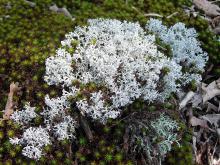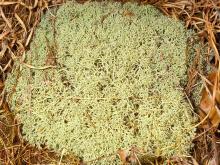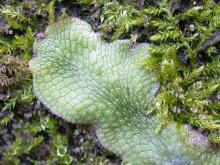Mosses, Liverworts, and Lichens
Media

Species Types
Scientific Name
Cladina rangiferina (syn. Cladonia rangiferina)
Description
Gray reindeer lichen, also called reindeer moss, takes the form of bright ashy or silvery-gray, branching cushions that grow on the soil. The branch tips usually bend to point in the same direction, as if combed or blown by a strong wind.
Media

Species Types
Scientific Name
Cladina subtenuis (syn. Cladonia subtenuis)
Description
Dixie reindeer lichen, also called reindeer moss, takes the form of pale yellow-green, finely branched cushions that grow on the soil. This is the most common and widespread of Missouri’s reindeer lichen species.
Media

Species Types
Scientific Name
About 112 species in Missouri
Description
Liverworts, along with mosses, make forest floors, streamsides, and spring openings beautiful. They’re fascinating but overlooked.
Media

Species Types
Scientific Name
Acarospora spp.
Description
Cobblestone lichens , or cracked lichens, grow flat against their substrate and are textured like lumpy cobblestone streets or old, cracked paint, or they are broken into sections like the mud of a dried lake. Depending on species, the color can range from white to greenish gray to brown to bright yellow.
Media

Species Types
Scientific Name
About 436 species in Missouri
Description
A lichen is a composite organism formed by certain fungus species that join with certain algae species. Lichens can be many colors and can be crusty, leaflike, flaky, branching, or mossy. They grow on rocks, trees, or other surfaces.
Media

Species Types
Scientific Name
Caloplaca spp.
Description
Firedot lichens are usually orange, yellow, rusty, or brown and look like tiny dots on a surface. To see these crustose lichens well, you often must get on your hands and knees and use a hand lens.
Media

Species Types
Scientific Name
Candelariella spp.
Description
Goldspeck lichens are orange to yellow crustose lichens that are frequently seen growing on rocks, wood, or other substrates. Missouri has about three species.
Media

Species Types
Scientific Name
Entodon seductrix
Description
Glossy moss, or shiny or seductive endoton, is a common Missouri moss with broad, glossy leaves that are pressed tightly against the stems. It forms large, dense mats that sometimes cover an entire boulder or log.
Media

Species Types
Scientific Name
Atrichum spp.
Description
Missouri has five species of starburst mosses (genus Atrichum). They tend to look different depending on whether they are wet or dry. When wet, they look like mass of bright green stars, but when dry, the leaves shrivel, contort, and look dead.
Media

Species Types
Scientific Name
Polytrichum juniperinum
Description
Juniper haircap moss is common and easy to recognize, since it looks like a tiny forest of juniper sprigs. It’s called a haircap moss because the young capsules have densely hairy caps.
See Also
About Mosses, Liverworts, and Lichens in Missouri
Mosses, liverworts, hornworts, and lichens seem rather similar, but these organisms are in very different groups. Mosses, liverworts, and hornworts are small, low plants usually found in damp habitats. Unlike more familiar plants, they lack veinlike structures and do not produce flowers or seeds — instead, they produce spores. Meanwhile, lichens are not plants at all: they are a collection of different fungi that have photosynthetic algae living within their tissues.





















